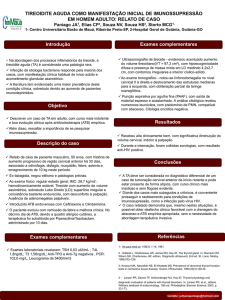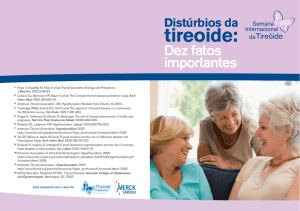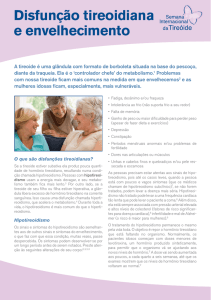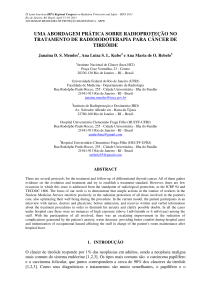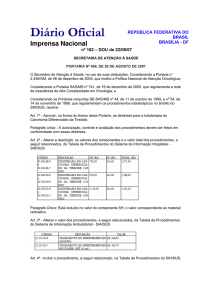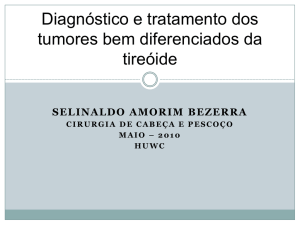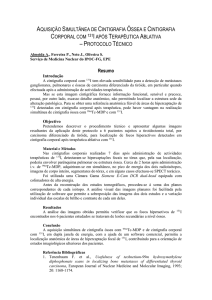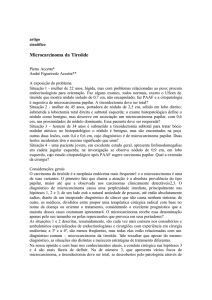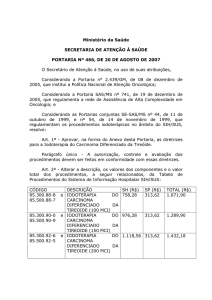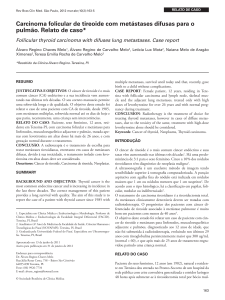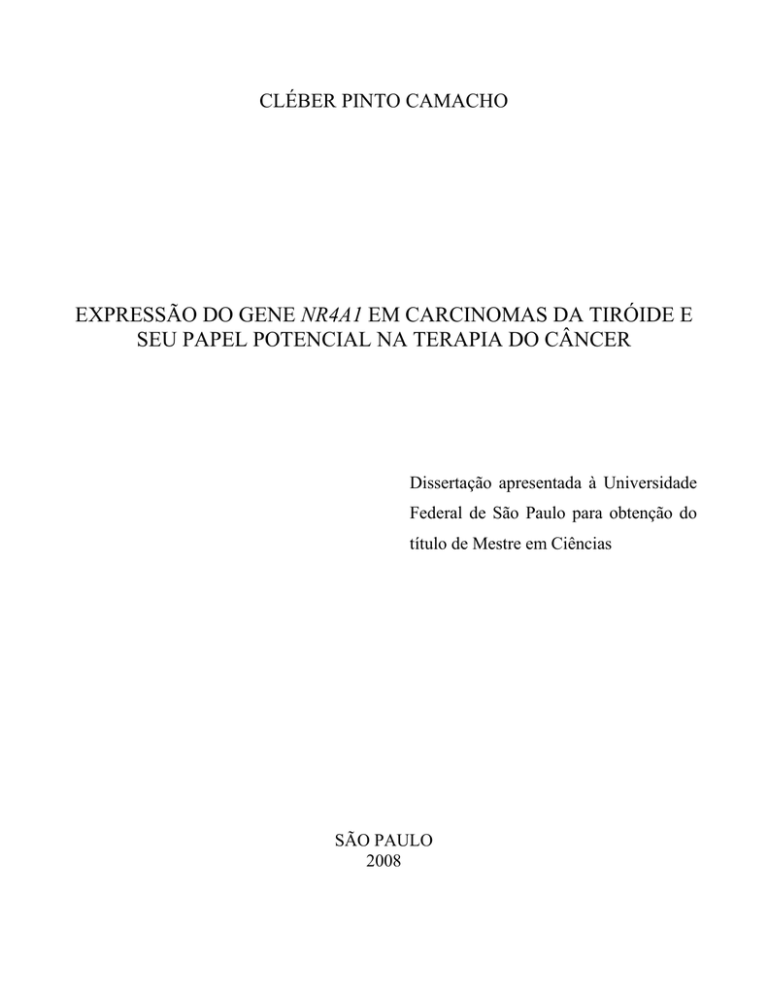
CLÉBER PINTO CAMACHO
EXPRESSÃO DO GENE NR4A1 EM CARCINOMAS DA TIRÓIDE E
SEU PAPEL POTENCIAL NA TERAPIA DO CÂNCER
Dissertação apresentada à Universidade
Federal de São Paulo para obtenção do
título de Mestre em Ciências
SÃO PAULO
2008
CLÉBER PINTO CAMACHO
EXPRESSÃO DO GENE NR4A1 EM CARCINOMAS DA TIRÓIDE E
SEU PAPEL POTENCIAL NA TERAPIA DO CÂNCER
Dissertação apresentada à Universidade
Federal de São Paulo para obtenção do
título de Mestre em Ciências
ORIENTADOR: Prof. Dr. Rui Monteiro de Barros Maciel
CO-ORIENTADORA: Profa. Dra. Janete Maria Cerutti
SÃO PAULO
2008
Camacho, Cléber Pinto
EXPRESSÃO DO GENE NR4A1 EM CARCINOMAS DA TIRÓIDE E SEU PAPEL
POTENCIAL NA TERAPIA DO CÂNCER, São Paulo, 2008
p. 41
Tese de Mestrado – Disciplina de Endocrinologia - Universidade Federal de São Paulo, Escola
Paulista de Medicina
Orientador: Prof. Dr. Rui Monteiro de Barros Maciel
Co-orientadora: Profa. Dra. Janete Maria Cerutti
Descritores: NR4A1, CCND1, FOSB, Câncer de Tiróide – Neoplasias Foliculares – Linhagens
Celulares da Tiróide – Expressão Gênica – SAGE – PCR em Tempo Real – Lítio
UNIVERSIDADE FEDERAL DE SÃO PAULO
ESCOLA PAULISTA DE MEDICINA
CURSO DE PÓS-GRADUAÇÃO EM ENDOCRINOLOGIA
TESE DE MESTRADO
AUTOR: Cléber Pinto Camacho
ORIENTADOR: Prof. Dr. Rui Monteiro de Barros Maciel
CO-ORIENTADOR: Profa Dra. Janete Maria Cerutti
TÍTULO: EXPRESSÃO DO GENE NR4A1 EM CARCINOMAS DA TIRÓIDE E SEU
PAPEL POTENCIAL NA TERAPIA DO CÂNCER
BANCA EXAMINADORA:
MEMBROS EFETIVOS:
1. Profa. Dra. Laura S. Ward
2. Profa. Dra. Léa Maria Zanini Maciel
3. Prof. Dr. Magnus Regios Dias da Silva
MEMBRO SUPLENTE
1. Profa. Dra. Denise Pires de Carvalho
Data: 28 de Novembro de 2007
À minha esposa, Dáfne, a quem devo os momentos
alegres e o apoio nos momentos difíceis. Companheira que
trilha comigo os mesmos caminhos, os mesmos desafios,
dividindo problemas e sucessos.
Aos meus pais, Manoel e Célia, a quem devo o esforço
pela minha educação e o incentivo para seguir adiante, não
importando a distância ou as pedras no caminho.
À minha irmã, Keite, pela amizade e pela percepção
diferenciada do mundo.
Ao Prof. Dr. Rui M. B. Maciel, meu obrigado pelos
desafios que me fizeram pensar. Pelas discussões que me
fizeram aprender. Pelos ensinamentos que me fizeram
saber ensinar. Muito obrigado pela amizade que me
permitiu continuar.
À Profa. Dra. Janete Maria Cerutti, um ícone de
seriedade, dedicação e profissionalismo, a quem devo
muito do meu aprendizado em biologia molecular e a
ajuda nos passos dados durante o desenvolvimento desta
tese.
Agradecimentos
Não seria possível listar todos aqueles que influenciaram minha vida para que ela convergisse
neste caminho e neste trabalho, mas posso registrar aqui o agradecimento àqueles que mais diretamente
participaram deste momento. Pessoas muito especiais que influenciaram a minha vida, das quais desejo
para sempre me lembrar.
Inicialmente gostaria de agradecer à Profª Drª Denise Câmara Lamego Martins, que me
incentivou a seguir a vida acadêmica e despertou meu interesse inicial pela Tiroidologia.
Agradeço a amizade dos colegas endocrinologistas Magnus, Rosa Paula, Claudia Nakabashi,
Daniele e Maria Izabel, com quem convivi nos ambulatórios e nas bancadas, amigos que
transformaram a assistência aos pacientes e a pesquisa em um aprendizado ainda mais rico. Não
poderia me esquecer das endocrinologistas Maria da Conceição e Elza, que através do apoio e amizade
me ajudaram a prosseguir.
Agradeço também aos amigos do Laboratório de Endocrinologia Molecular: Adriana, Gustavo,
Gisele, Flávia, Rosana, Mariana e Felipe; com os quais aprendi, através de acertos e erros, técnicas e
protocolos. Amigos de bancada, dedicados à pesquisa, com os quais passei grande parte dos meus dias
e, muitas vezes, noites, trabalhando na bancada, e com os quais comecei a enxergar um mundo
invisível que nos cerca.
Uma lembrança especial para Gisele Oler e Flávia Latini, pela colaboração e sugestões que
foram muito importantes para o trabalho, amigas sem as quais este caminho teria sido mais tortuoso e
muito menos divertido.
Agradeço também aos amigos Teresa, Ilda e Gilberto, pelo ombro amigo sempre presente, pela
compreensão nos momentos difíceis e pelas discussões que me ajudaram a resolver problemas durante
a realização deste trabalho.
Ao Prof. Dr. Reinaldo Furlanetto e à Profa Dra Luiza Matsumura, pelos ensinamentos, conselhos
e discussões sobre a Endocrinologia e sobre a vida.
Às secretárias Ângela, Yeda e Amarillys, pela atenção especial e carinho, pelos quais serão
sempre lembradas.
Aos alunos e residentes que me permitiram ensinar, e com os quais muito aprendí.
A todos os pacientes, pela colaboração, pois sem eles este trabalho e os seus ensinamentos não
teriam sentido.
Ao Prof. Dr. Sérgio Atala Dib, coordenador da Pós-Graduação, pela atenção, discussões e todos
os ensinamentos.
À CAPES, pela contribuição financeira através da concessão da bolsa de mestrado.
Índice
APRESENTAÇÃO ___________________________________________________________i
INTRODUÇÃO
____________________________________________________________1
OBJETIVOS
____________________________________________________________4
MANUSCRITO
____________________________________________________________5
CONCLUSÕES
____________________________________________________________27
BIBLIOGRAFIA ____________________________________________________________28
APRESENTAÇÃO
Nesta tese de mestrado, realizada com apoio financeiro da CAPES e da FAPESP (05/60330-8),
intitulada “EXPRESSÃO DO GENE NR4A1 EM CARCINOMAS DA TIRÓIDE E SEU PAPEL
POTENCIAL NA TERAPIA DO CÂNCER” apresentamos, de acordo com as recomendações da
comissão especial do programa de Pós-Graduação em Endocrinologia da Universidade Federal de São
Paulo (UNIFESP), um trabalho em forma de manuscrito que será submetido à revista Clinical
Endocrinology.
O trabalho foi desenvolvido no laboratório de Endocrinologia Molecular da UNIFESP. Por
orientação do Prof. Dr. Rui Maciel e da Profª Dra Janete Cerutti, estabelecemos como foco os tumores
foliculares da tiróide, em particular o perfil de expressão gênica de suas células tumorais. A partir das
bibliotecas geradas através da técnica SAGE, trabalho este da Profª Drª Janete Maria Cerutti, em
colaboração com o Prof. Dr. Gregory J. Riggins, pudemos selecionar genes candidatos ao estudo (1).
Todas as bibliotecas de Tags geradas estão disponíveis no site do Cancer Genome Anatomy Project
(CGAP) para download ou análise - http://cgap.nci.nih.gov/SAGE.
Identificamos genes cuja expressão estava diminuída nas bibliotecas de carcinoma folicular de
tiróide (FTC): TPO, TFF3, NR4A1 e IYD. O NR4A1 foi selecionado para uma análise mais profunda,
por apresentar expressão potencialmente tecido-específica. Passamos então à validação do padrão
diferencial de expressão em tecidos neoplásicos e não-neoplásicos, pela técnica de PCR em tempo real,
assim como a realização de experimentos em linhagens celulares, com o uso de lítio. Estes são os focos
desta tese e estão descritos no manuscrito “Downregulation of NR4A1 in follicular thyroid
carcinoma cell line is restored after lithium treatment”.
i
Durante todo o período em que estive desenvolvendo esta pesquisa, acompanhei e participei de
vários outros trabalhos de teses relacionados com doenças malignas e benignas da tiróide e que
resultaram em publicações onde sou co-autor (2-5).
Reis EM, Ojopi EP, Alberto FL, Rahal P, Tsukumo F, Mancini UM, Guimarães GS,
Thompson GM, Camacho C, Miracca E, Carvalho AL, Machado AA, Paquola AC, Cerutti
JM, da Silva AM, Pereira GG, Valentini SR, Nagai MA, Kowalski LP, Verjovski-Almeida
S, Tajara EH, Dias-Neto E, Bengtson MH, Canevari RA, Carazzolle MF, Colin C, Costa FF,
Costa MC, Estécio MR, Esteves LI, Federico MH, Guimarães PE, Hackel C, Kimura ET,
Leoni SG, Maciel RM, Maistro S, Mangone FR, Massirer KB, Matsuo SE, Nobrega FG,
Nóbrega MP, Nunes DN, Nunes F, Pandolfi JR, Pardini MI, Pasini FS, Peres T, Rainho CA,
dos Reis PP, Rodrigus-Lisoni FC, Rogatto SR, dos Santos A, dos Santos PC, Sogayar MC,
Zanelli CF; Head and Neck Annotation Consortium. 2005 Large-scale transcriptome
analyses reveal new genetic marker candidates of head, neck, and thyroid cancer. Cancer
Res 65:1693-9
Biscolla RP, Ikejiri ES, Mamone MC, Nakabashi CC, Andrade VP, Kasamatsu TS, Crispim
F, Chiamolera MI, Andreoni DM, Camacho CP, Hojaij FC, Vieira JG, Furlanetto RP,
Maciel RM. 2007 [Diagnosis of metastases in patients with papillary thyroid cancer by the
measurement of thyroglobulin in fine needle aspirate]. Arq Bras Endocrinol Metabol
51:419-25
Guimaraes GS, Latini FR, Camacho CP, Maciel RM, Dias-Neto E, Cerutti JM 2006
Identification of candidates for tumor-specific alternative splicing in the thyroid. Genes
Chromosomes Cancer 45:540-53
ii
Tamanaha R, Camacho CP, Ikejiri ES, Maciel RM, Cerutti JM 2007 Y791F RET mutation
and early onset of medullary thyroid carcinoma in a Brazilian kindred: evaluation of
phenotype-modifying effect of germline variants. Clin Endocrinol (Oxf) 67:806-8
Também participo de outros trabalhos como co-autor que estão aceitos para publicação ou submetidos
à publicação:
Gisele Oler, Cléber P. Camacho, Flávio C. Hojaij, Pedro Michaluart Jr., Gregory J.
Riggins and Janete M. Cerutti. Gene Expression Profiling of Papillary Thyroid Carcinoma
Identifies Transcripts that Are Correlated with BRAF Mutational Status and Lymph Node
Metastasis. Aceito para publicação, Clinical Cancer Research.
Helton E. Ramos, Leando A. Diehl, Cléber P. Camacho, Petros Perros, Hans Graf.
“Management of Graves’ Orbitopathy in Latin America: an International Questionnaire
Study compared with Europe”. Aceito para publicação, Clinical Endocrinology
Rosana Tamanaha, Cléber P. Camacho, Alexandre C. Pereira, Adriana M. Álvares da
Silva, Rui M.B. Maciel and Janete M. Cerutti. Evaluation of RET polymorphisms in a sixgeneration family with G533C RET mutation: specific RET variants may modulate age at
onset and clinical presentation. Submetido à revista The Journal of Clinical
Endocrinology and Metabolism.
Ricardo A. Guerra, Felipe Crispim, Cláudia C. D. Nakabashi, Cleber P. Camacho,
Teresa S. Kasamatsu, Rui M. B. Maciel. "Thyroglobulin is still detectable in the serum of
normal individuals after a trial of TSH-suppressive doses of L-T4 during 3 months".
Submetido à revista Thyroid
iii
Helton E. Ramos, Valter T. Boldarine, Suzana Nesi-França, Cleber P. Camacho,
Gustavo S. Guimarães, Magnus R. Dias da Silva, Hans Graf, Luiz de Lacerda, Gisah A.
Carvalho, Rui M. B. Maciel. "NKX2.5 missense mutations are associated with thyroid
ectopy: a study of 157 patients with thyroid dysgenesis". Submetido à revista Journal of
Clinical Endocrinology and Metabolism
Helton E. Ramos, Suzana Nesi-França, Valter T. Boldarine, Rosana M. Pereira, Maria
Izabel Chiamolera, Cleber P. Camacho, Hans Graf, Luiz de Lacerda, Gisah A. Carvalho,
Rui M. B. Maciel. "Clinical and Molecular Analysis of Thyroid Hypoplasia: A
Population-based Approach in Southern Brazil". Submetido à revista Thyroid.
iv
INTRODUÇÃO
As neoplasias malignas da tiróide são as neoplasias endócrinas mais comuns (90%) e
respondem por mais da metade das mortes por cânceres endocrinológicos. O uso da ultra-sonografia na
avaliação da doença nodular da tiróide foi de extrema importância ao auxiliar o diagnóstico precoce
destas neoplasias, mas ao mesmo tempo gerou um grande problema, já que aumentou a incidência de
nódulos tiroidianos para até 67% (6).
Este aumento da incidência dos nódulos tiroidianos teve duas conseqüências inevitáveis: o
aumento do número de citologias aspirativas com agulha fina (CAAF) com diagnóstico indeterminado
e o aumento na incidência da neoplasia maligna da tiróide, basicamente pelo aumento da detecção de
carcinomas papilíferos pequenos (7).
Até o momento, os diagnósticos indeterminados representam 10 a 20% das CAAF. A incapacidade
diagnóstica dos métodos tradicionais, particularmente da CAAF (8), gerou uma corrida dos centros de
pesquisa por métodos alternativos que conseguissem aumentar a sensibilidade e especificidade de tal
citologia.
Mesmo antes desta “epidemia relativa” de cânceres de tiróide, já se pesquisavam os mecanismos
responsáveis pela gênese das neoplasias malignas da tiróide (9, 10). Assim, dentre os eventos
relacionados com a gênese do câncer tiroidiano, identificou-se o gene RET, que codifica uma proteína
cinase transmembrana, a qual, através do rearranjo com outros genes, é relacionada com a gênese do
carcinoma papilífero da tiróide. Além disso, a mutação ativadora do RET foi relacionada com a gênese do
carcinoma medular da tiróide. Recentemente, identificou-se a mutação V600E no BRAF como sendo o
evento responsável pela maioria dos casos de carcinoma papilífero.
1
No entanto, o maior desafio cerca o carcinoma folicular da tiróide (FTC), que apresenta as
características de célula tiroidiana diferenciada, mas que não evidencia alterações nucleares
características do carcinoma papilífero da tiróide, as quais permitem o diagnóstico deste subtipo através
da CAAF. Seu diagnóstico tem sido realizado apenas histologicamente, depois da cirurgia, por meio da
identificação de invasão tumoral da cápsula, dos vasos ou do tecido tiroidiano adjacente, o que o
diferencia do adenoma folicular da tiróide (FTA), lesão benigna. O FTC pode responder por até 50%
dos tumores diferenciados da tiróide, com maior freqüência em regiões carentes de iodo (11).
O FTC pode se apresentar sob duas formas: uma minimamente invasiva (MIFC) e a outra
extensamente invasiva (WIFC). A MIFC apresenta um prognóstico semelhante ao do FTA, sendo
necessária avaliação criteriosa por parte do patologista, para que este subtipo seja corretamente
classificado. O WIFC é mais facilmente diferenciado das lesões benignas. Mesmo na forma WIFC, é
extremamente rara a ocorrência de metástase para linfonodos cervicais, sendo observadas, em 5 a 20%
dos casos, metástases à distância, principalmente para pulmões e ossos.
Vários fatores moleculares foram até agora apontados como participantes da patogênese do
FTC, mas nenhum deles pode ser considerado como sua causa predisponente principal (10). Assim,
mutações ativadoras do oncogene RAS são conhecidas há algum tempo e estão presentes em
aproximadamente 40% dos FTC, mas podem ser encontradas também em até 20% do FTA e em 10%
dos carcinomas papilíferos da tiróide (12).
Kroll e cols. nos levaram a acreditar que o desafio de identificar um evento responsável por esta
neoplasia havia chegado ao fim (13). No entanto, o rearranjo do PAX8 e do PPARγ também foi
encontrado em neoplasias benignas da tiróide (14). Ying e cols. geraram o primeiro modelo animal de
carcinoma folicular da tiróide através de uma mutação no receptor do hormônio tiroidiano (15).
2
Apesar da fisiopatologia do FTC continuar desconhecida, Cerutti e cols. conseguiram identificar
4 novos marcadores: DDIT3, ARG2, ITM1 e Clorf24, que, quando usados em combinação, são capazes
de distinguir as lesões adenoma folicular de carcinoma folicular com alta sensibilidade e especificidade
(1). Estudo posterior demonstrou que tais marcadores distinguem outras lesões da tiróide comumente
classificadas como padrão folicular (16) e, desta forma, representaram um grande passo na questão das
CAAF indeterminadas, além de ser uma pista importante na determinação das vias envolvidas na
patogênese do carcinoma folicular da tiróide.
O tratamento atual dos tumores diferenciados da tiróide é baseado na realização da
tiroidectomia total e da radioiodoterapia, sendo eficiente na grande maioria dos casos. No entanto,
naqueles pacientes em que estes procedimentos não foram capazes de alcançar a cura, a radioterapia
externa e a quimioterapia são os procedimentos alternativos existentes e apresentam resultados
variáveis. O lítio e o ácido retinóico são usados como adjuvantes ao radioiodo, sendo observados
resultados insatisfatórios. A pesquisa com novas drogas para alvos moleculares é uma nova esperança,
mas no caso do FTC, ainda não foram identificados tais alvos (17).
Neste contexto, iniciamos a busca por genes diferencialmente expressos que pudessem ser
avaliados em modelos experimentais e que tivessem um papel potencial na terapia do câncer, sendo
este o enfoque do manuscrito a seguir.
3
OBJETIVOS
1) Validar a expressão de NR4A1 nos tecidos benignos e malignos da tiróide.
2) Avaliar a correlação dos genes CCND1 e FOSB com a expressão de NR4A1.
3) Verificar a expressão dos genes NR4A1, CCDN1 e FOSB nas linhagens de carcinoma tiroidiano
disponíveis no laboratório, com objetivo de indetificar um modelo semelhante a expressão observada
nos tecidos.
4) Verificar se a expressão dos genes NR4A1, FOSB e CCDN1 poderia ser restabelecida quando
tratadas com lítio.
4
Down-regulation of NR4A1 in follicular thyroid carcinomas is restored following
lithium treatment
Cléber P. Camacho1,2, Flavia R. M. Latini1,2, Gisele Oler1,2, Flavio C. Hojaij3, Rui M. B. Maciel1, Gregory J.
Riggins4 and Janete M. Cerutti1,2
1
Genetic Bases of Thyroid Tumors Laboratory, Division of Genetics, Department of Morphology, 2Laboratory of
Molecular Endocrinology, Division of Endocrinology, Department of Medicine; and 3Division of Head and
Neck Surgery, Federal University of São Paulo, São Paulo, Brazil; 4Departament of Neurosurgery, Johns
Hopkins University Medical School, Baltimore, Maryland, USA
Correspondence:
Janete Cerutti, Ph.D.
Genetic Bases of Thyroid Tumor Laboratory
Rua Pedro de Toledo 669, 11° andar.
Federal University of São Paulo
04039-032, São Paulo, SP, Brazil
Phone: +55-11-5081-5233 fax: +55-11-5084-5231
E-mail: [email protected]
Running title: NR4A1 expression in thyroid tumors
Key words: Follicular Thyroid Carcinoma, NR4A1, CCND1, FOSB and lithium.
Acknowledgements: We gratefully acknowledge funding from the São Paulo State Research Foundation
(FAPESP) grants 05/60330-8, NIH Grant CA113461, and the Ludwig Center at Johns Hopkins. CPC is a scholar
from CAPES, JMC and RMBM are investigators of the Brazilian Research Council (CNPq), GO and FRML are
scholars from FAPESP and GJR is the the Irving J. Sherman M.D. Neurosurgery Research Professor.
5
Abstract
Introduction: The identification of follicular thyroid adenoma-associated transcripts will lead to a better
understanding of the events involved in pathogenesis and progression of follicular tumors. Using Serial Analysis
of Gene Expression, we identified five genes that are absent in a malignant follicular thyroid carcinoma (FTC)
library, but expressed in follicular adenoma (FTA) and normal thyroid libraries.
Methods: NR4A1, one of the five genes, was validated in a set of 27 normal thyroid tissues, 10 FTAs and 14
FTCs and three thyroid carcinoma cell lines by real time PCR. NR4A1 can be transiently increased by a variety
of stimuli, including lithium, which is used as adjuvant therapy of thyroid carcinoma with
131
I. We tested if
lithium could restore NR4A1 expression. The expression of other genes potentially involved in the same
signaling pathway was tested. To this end, lithium was used at different concentration (10mM or 20mM) and time
(2h and 24 h) and the level of expression was tested by quantitative PCR. We next tested if Lithium could affect
cell growth and apoptosis.
Results: We observed that NR4A1 expression was under-expressed in most of the FTCs investigated, compared
to expression in normal thyroid tissues and FTAs. We also found a positive correlation between NR4A1 and
FOSB gene expression. Lithium induced NR4A1 and FOSB expression, reduced CCDN1 expression, inhibited
cell growth and triggered apoptosis in a FTC cell line.
Conclusions: NR4A1 is under-expressed in most of FTCs. The loss of expression of both NR4A1 and the Wnt
pathway gene FOSB was correlated with malignancy. This is consistent with the hypothesis that its loss of
expression is part of the transformation process of FTCs, either as a direct or indirect consequence of Wnt
pathway alterations. Lithium restores NR4A1 expression, induces apoptosis and reduces cell growth. These
findings may explain a possible molecular mechanism of lithium’s therapeutic action.
6
Introduction
The number of thyroid cancer cases is increasing and for women this malignancy has one of the highest
rates of increased incidence in the United States. Papillary thyroid carcinoma (PTC) and follicular thyroid
carcinoma (FTC) are the most frequent thyroid cancer subtypes1 . During the last two decades we have seen
progress in our understanding of the molecular biology of these cancers. The importance of the MAPK pathway
has been identified in PTC, resulting from RAS/BRAF mutations or rearrangements of the RET oncogene
2-4
.
Less is known about the molecular events underlying FTC.
The most frequent genetic alterations in FTC comprise point mutations of the RAS genes and PAX8PPARγ rearrangements. Although they were initially proposed as potentially associated with pathogenesis of
FTC, these genetic events also occur with significant prevalence in FTA5-9 .Although it has been suggested that
those FTAs with PAX8-PPARγ are more likely to transform into a malignant tumor10,
11
, to date there is no
compelling in vitro or in vivo evidence. Moreover, a high proportion of FTCs are negative for the rearrangement7
and, therefore, unrevealed genes or pathways may be involved in the pathogenesis of this type of thyroid tumor.
The identification of novel FTA-associated transcripts, could lead to a better understanding of the events
involved in pathogenesis and progression of FTC. We compared the gene expression profiles of three SAGE
libraries generated from thyroid tumors and a normal thyroid tissue12, 13 . The expression analysis was performed
originally to locate clinical markers and the data are posted at http://cgap.nci.nih.gov/SAGE. Using SAGE
Digital Gene Expression Displayer (DGED), a tool to compare SAGE libraries, we identified five genes that are
expressed in normal thyroid and FTA but not expressed in the malignant FTC. One of these genes, NR4A1,
encodes an orphan member of the steroid/thyroid/retinoid super-family, whose members act mainly as
transcription factors that induce or repress gene expression14 . NR4A1 (Nuclear receptor subfamily 4, group A,
member 1) was of particular interest because it was under-expressed in several tumors compared with the
corresponding normal tissues15, 16 and because NR4A1 appears to up-regulate pro-apoptosis genes17, 18 .
Consequently, one can hypothesized that lost or reduced NR4A1 expression in tumors may be associated
with malignant transformation of follicular thyroid cells. Although the mechanisms involved in the
7
transcriptional regulation of NR4A1 is not completely understood, it was described as a target of Wnt-1
(Wingless-type MMTV integration site family, member 116 . The best understood Wnt pathway is the canonical
pathway, which controls cell proliferation through inhibition of glycogen synthase kinase-3 beta (GSK3β) and
increase in transcriptional activation of β-catenin targets. Although the authors described NR4A1 as a Wnt-1
responsive gene with decreased expression in tumors, they suggested that NR4A1 may be up-regulated by a
noncanonical Wnt signaling pathway16 .
NR4A1 was also of interest because its expression can be transiently increased by a variety of stimulus,
including lithium a drug that has been used to therapy of thyroid cancer16, 19-21 . It was shown that lithium acts as
a specific inhibitor of the glycogen synthase kinase-3 beta (GSK3β). Although Lithium has been used as
adjuvant to the 131I therapy of thyroid cancer, the cellular target of lithium is still unknown.
We investigated the expression of NRA41 in a set of normal thyroid tissues, FTAs and FTCs.
Subsequently, we investigated the level of expression of other genes downstream the Wnt signaling pathway and
correlate their expression with NR4A1 expression. We next sought to test whether lithium could restore the
NR4A1 expression in thyroid cell lines and explain a possible molecular mechanism for the effect of lithium as
an adjuvant therapy for thyroid cancer.
8
Material and Methods
SAGE Digital Gene Expression Displayer. DGED was used to identify genes differentially expressed between
benign (normal tissue and FTA) and malignant (FTC) SAGE libraries. The full set of tag counts for all thyroid
libraries is available for downloading or analysis at the Cancer Genome Anatomy Project SAGE Genie Web site
(http://cgap.nci.nih.gov/SAGE)12 . To identify genes differentially expressed, we defined as criteria P <0.05 and
10-fold difference in the level of expression between the two groups (Fig. 1).
Tissue Specimens. A total of 41 thyroid tissue specimens obtained from patients undergoing thyroid surgery for
thyroid disease at Hospital São Paulo, Federal University of São Paulo, Brazil, were used in this study. Samples
were frozen immediately after surgery and stored at -80°C and included 27 normal thyroids (NTs) 10 FTAs and
14 malignant (FTCs) tissues. Among 14 FTCs, 6 were classified as widely invasive follicular thyroid tumors
(WIFC) (capsular and vascular invasion and extension of the tumor beyond the thyroid gland). All tissue
samples were obtained with informed consent according to established Human Studies Protocols at Federal
University of São Paulo. The study of patient materials was conducted according to the principles expressed in
the Declaration of Helsinki.
Cell Lines. A FTC (WRO), PTC (NPA) and an undifferentiated thyroid carcinoma (ARO) cell lines used in this
study were previously characterized22-25 . Cell lines were grown in DMEM (Invitrogen Corp., Carlsbad, CA)
supplemented with 10% FBS (Invitrogen), with 100 units/mL of penicillin and 100 µg/mL streptomycin in a
humidified incubator containing 5% CO2 at 37ºC as described26, 27 .
RNA extraction and cDNA synthesis and quantitative PCR (qPCR). Total RNA isolation and cDNA synthesis
were performed as previously reported13 . Briefly, one microgram of total RNA was treated with a DNAse
(Ambion, Austin, TX) and was reverse-transcribed to cDNA using Super-Script II Reverse Transcriptase kit with
an oligo(dT)12-18 primer and 10 units of RNase inhibitor (Invitrogen). An aliquot of cDNA was used in 20µL
PCR reaction containing SYBR Green PCR Master Mix and 200 nM of each primer for the target (NR4A1,
CCDN1 and FOS) or reference genes (ribosomal protein S8 and QPC). Primers were designed using Primer3
software (http://frodo.wi.mit.edu/cgi-bin/primer3/primer3_www.cgi). The PCR reaction was performed for 40
9
cycles of a 4-step program: 94oC for 15 sec, annealing temperature for 20 sec, 72oC for 20 sec, and a
fluorescence-read step for 20 sec. qPCR reactions were performed in triplicate. The threshold cycle (Ct) was
obtained using Applied Biosystem software and was averaged (SD ≤1). Gene expression was normalized using
the average of 2-reference genes. Fold changes were calculated as previously described28 .
NR4A1, FOSB and CCDN1 Expression after Lithium Treatment. 5 × 106 cells WRO cells were plated in 35mm
plates. After 24 hours, cells were harvest with fresh medium containing lithium chloride (LiCl; Sigma-Aldrich
Corp. St. Louis, MO, USA). Concentration (10mM and 20mM) and time (2 and 24 hours) were determined
according to previous studies16, 29 . Doses of 10mM and 20mM lithium are commonly used to achieve GSK3β
inhibition and activation of Wnt/β-catenin signaling29. Total RNA isolation, cDNA synthesis and qPCR for
NR4A1, FOSB, CCDN1 and reference genes were performed as described above. Additionally, the SodiumIodide-Symporter (NIS) expression was tested following lithium treatment.
MTT Assay. We next investigated the effect of lithium on cell proliferation. In brief, 2 x 104 WRO cells were
seeded in 35-mm in quintuplicate, allowed to adhere overnight, and then treated with lithium at 10mM and 20mM
concentrations. At each time point, cell growth rates were analyzed following addition of 3,4-(4,5dimethylthiazol-2-yl)-2.5-diphenyltetrazolium bromide (MTT) (Sigma) reagent to the cultured cells as
described30 . Absorbance was measured using spectrophotometer at a wavelength of 560 nm.
Apoptosis Assay. We investigated if lithium could induce apoptosis in WRO cells. Briefly, 2 × 104 cells WRO
cells were plated in 35mm plates in quintuplicate. Cells were then treated with lithium at 10mM and 20mM
concentrations. At indicated time, Annexin V–positive cells were measured using the Guava Nexin kit as
described30 .
Statistical Analysis. qPCR values were log-transformed before application of statistical tests. Unpaired student t
test was used to examine differences between two groups and ANOVA with Bonferroni correction was used to
examine differences among groups (StatView software). To test the significance of the relationship between
genes, Pearson correlation was used. Chi-squared (X2) with odds ratio (OR) was performed to determine the risk
for tumorigenesis. A P value of < 0.05 was considered significant.
10
Results
Genes Potentially Associated with Pathogenesis of Thyroid tumors. Differentially expressed genes can be found
by comparison of various SAGE libraries using the SAGE Digital Gene Expression Display (SAGE DGED)31 .
We compared two pools of thyroid SAGE libraries. Pool A included both normal thyroid and FTA and pool B
consisted of FTC library. Using P <0.05 as the value for statistical significance and 10-fold as the difference in
the level of expression, we identified 6 transcripts differentially expressed between pool A and pool B. Our
primary focus was on genes whose expression was lower in FTC library such as TPO, TFF3, NR4A1, and IYD
(Fig. 1). NR4A1 was selected for further investigation.
NR4A1 Expression in Thyroid Tissues. The data predicted by SAGE was validated by qPCR using a set of 27
normal thyroid tissues, 10 FTAs and 14 FTCs. We observed that NR4A1 expression was under-expressed in most
FTCs investigated (65%), compared with the expression observed in normals (P=0.01) and FTAs (Fig. 2A). The
expression was remarkably lower in widely invasive follicular carcinoma than adenoma (P=0.02) (Fig. 2B). To
determine the risk of tumorigenesis, the level of NR4A1 expression was analyzed in FTCs (n=14) and normal
thyroid (n=22) groups. Using 0.1 as the cutoff value, expression levels lower than 0.1 were observed in 5 of 22
normal thyroids and 8 of 14 FTCs. A low level of NR4A1 expression was associated with an increased risk of
FTC (Odds ratio= 5.8; χ2:6,352; P = 0.0117; IC95%: 1.39 – 24.67). To provide a more accurate estimate of the
risks of malignancy associated with NR4A1 level of expression, a larger series and absolute values are needed.
FOSB and CCND1expression in thyroid Samples. Since NR4A1 was suggested as downstream of Wnt-1
signaling pathway, we investigated the expression of canonical Wnt-1 target genes such as FOSB and CCDN1.
Additionally, we sought to determine whether there is a correlation among expression levels for NR4A1, FOSB
and CCND1.
FOSB was under-expressed in most of thyroid carcinomas and a number of FTAs compared to normal
thyroid, although not significant (Fig. 2C). Intriguingly, CCDN1 was over-expressed in both FTCs (P < 0.01)
and FTAs (P = 0.01), compared to normal thyroid (Fig. 2D).
11
We found a positive correlation between NR4A1 and FOSB genes in normal tissue (P= 0.0065),
adenoma (P= 0.0429) and carcinoma tissue (P= 0.0020) (Fig. 2E). There was no correlation between NR4A1 and
CCND1 (Fig. 2F).
Lithium restores NR4A1 and FOSB expression and reduced CCND1 expression in FTC cell line. We next
investigated expression levels of NR4A1, CCND1 and FOSB in thyroid carcinoma cell lines: NPA, ARO and
WRO. NR4A1 and FOSB were under-expressed in all cell lines compared to normal thyroid. CCND1 was overexpressed in WRO, compared to normal thyroid (Fig. 3A, B and C). Since the WRO follicular thyroid carcinoma
cell line had patterns expression of the tested genes similar to those observed in FTCs, it was selected for further
analysis.
WRO cells were cultured in medium containing Lithium Chloride (LiCL) at different concentrations and
time and the level of expression of selected genes were determined. In multiple experiments, qPCR analysis
showed a consistent increased of NR4A1 transcripts in 2h lithium-treated cells compared with untreated controls,
in a dose-dependent manner. A greater effect was observed when cells were treated with 20 mM LiCl for 2 h (Fig
4A). After 24 h, NR4A1 expression was up-regulated only at high doses of lithium (Fig 4B). The expression of
FOSB, an early gene, was restored after 2 h treatment when 20 mM lithium was used and was down-regulated in
cells exposed to 10 mM LiCl for 2 h (Fig. 4C and D). FOSB was down-regulated in and 24 h lithium-treated cells
compared with untreated controls, in a dose-dependent manner (Fig. 4D).
The expression of CCND1 was biphasic with a slight increase at 2 h of lithium treatment followed by a
down-regulation at 24 h as compared with untreated control cells. Comparable effects of lithium on CCND1
expression were previously reported32 (Fig. 4E and 4F).
Since lithium has been suggested to act as an adjuvant to
131
I therapy by inhibiting its release from the
thyroid, we tested whether the expression of the sodium-iodide symporter (NIS) changed after lithium treatment.
We did not find any difference in expression of NIS in WRO-treated cells compared with non-treated controls
(data not shown).
12
Lithium inhibits cell growth and induces apoptosis in FTC cell line. Although controversy, previous studies
showed that over-expression of NR4A1 inhibited cell growth and induced apoptosis. Since lithium restores
NR4A1 expression in FTC cell line, we investigated the effect of lithium on cell growth and apoptosis. As
showed in Fig. 5A, lithium treatment resulted in a progressive and dose-dependant cell growth inhibition as
compared with the untreated control cells. The reduction in cell proliferation in 20 mM lithium treated cells was
statistically significant in all treatment points compared to control cells (P<0.001). To quantify the apoptotic rate
of WRO cells following treatment, different concentration of lithium were tested at 48 and 72 hours, a time in
which growth inhibition was more evident for both concentrations. Lithium significantly increased the number
of apoptotic cells in a time and dose-dependent manner (P<0.001) (Fig. 5B).
13
Discussion
In this study, using SAGE Digital Gene Expression Display and validation by qPCR, we found that
NR4A1 was under-expressed in most of FTCs compared to normal thyroid and FTA, and markedly lower in
widely invasive follicular thyroid carcinoma.
NR4A1, also known as Nur77, TR3 and NGFI-B, an orphan nuclear receptor, was first described as an
immediate early gene induced in response to serum or phorbol ester stimulation of quiescent fibroblasts.
Although it was initially known for its role in cell proliferation and differentiation, later was shown to be a
potent pro-apoptotic molecule in different cell types. Inhibition of NR4A1 activity either by over-expressing a
dominant-negative form or using antisense RNA, inhibited apoptosis33, 34 . Consistent with its apoptotic activity,
over-expression of NR4A1 in some cell lines leads to apoptosis. It was demonstrated that its apoptotic activity
can be altered through AKT-mediated phosphorylation in the DNA binding domain of NR4A1 and substantially
diminishes its ability to bind DNA and diminish its apoptotic activity35 . Others have suggested that NR4A1 is
phosphorylated through the ERK5 pathway36 . Moreover, it was suggested that NR4A1-mediated apoptosis
involves transcription-independent mitochondrial targeting of NR4A1. When induced by apoptotic stimuli,
NR4A1 translocates into the cytoplasm where it binds to Bcl2 and provokes conformational change of Bcl2. This
results in conversion of Bcl2 from a cell protector to a cell killer37, 38 .
Based on its apoptotic effects, many studies were performed searching for a link between tumorigenesis
and NR4A1 expression. NR4A1 expression was reduced in several tumor subtypes compared to normal matched
samples16 . Recently it was described that down-regulation of NR4A1 was a common feature in leukemia blast
cells from human acute myeloid leukemia (AML)39 . Additional evidence that supports a role for NR4A1 in
tumorigenesis comes from the observation that NR4A1 abrogation in mice led to a rapidly lethal and
transplantable leukemic disease with pathological features most closely resembling AML. Based on these
findings, it was suggested a new role of NR4A1, a critical tumor suppressor of myeloid leukemogenesis39 .
14
The aforementioned evidences of its potential role as a tumor suppressor gene and the fact that we found
a decreased expression of NR4A1 in follicular thyroid carcinomas compared to normal thyroid and FTA, suggest
that the down-regulation of NR4A1 expression might be an important event during thyroid tumorigenesis.
Given that NR4A1 induction is regulated by a variety of cell- and stimulus-specific such as growth
factors, calcium, inflammatory cytokines, peptide hormones, phorbol esters, neurotransmitters and lithium16, 19, 40,
we hypothesize whether these agents could restore the expression of NR4A1.
The effect of lithium on thyroid was first observed in patients who received lithium for mood diseases
and developed goiter41 . Later it was demonstrated that lithium inhibits the release of radioiodine from the
thyroid42 . Due to this effect lithium is considered an option for adjuvant treatment with radioiodine for selected
cases of thyroid cancers21, 43, 44 .
Based on the fact that lithium has been used as therapeutic drug for thyroid carcinomas for several years
but it therapeutic action remains an enigma and that it induces NR4A1 expression16 , we hypothesize that lithium
might exert its therapeutic effect by restoring the expression of NR4A1. We show here that when a follicular
thyroid carcinoma cell was exposed to 10 mM or 20 mM of lithium, NR4A1 expression increased at significant
levels after 2 hours of treatment, in a dose-dependent manner.
Additionally, since NR4A1 over-expression in response to a variety of stimuli and chemotherapeutic
agents was involved in growth suppression and apoptosis of many cell types18, 45 , we further examined if lithium
could trigger apoptosis and reduce cell growth in a FTC cell line. We demonstrated here that lithium inhibited
cell growth and induced apoptosis in a dose dependent manner. This helps implicate a potential role for NR4A1
in thyroid cells and therapeutic mechanism of lithium action. However, we do not know yet if induction of the
cell death pathway by lithium is accompanied by translocation of NR4A1 from the nucleus to the
cytosol/mitochondria or by post-trascriptional modification by ERK5 or by AKT-mediated phosphorylation.
These possibilities need further investigation.
Converse to our observations, it has been reported that 5 mM lithium stimulates proliferation of two
thyroid carcinoma cell lines (papillary and follicular). The authors suggested that inhibition of GSK3β by lithium
15
lead to an enhancement of proliferation by increasing the β-catenin levels29 and, therefore, mimic the canonical
Wnt/β-catenin signaling 29,46 . However, it was demonstrated that although the inhibition of the GSK3β pathway
occurred at concentrations as low as 1 mM lithium, substantial growth inhibition of tumor cells does not appear
until treatment with 10 mM lithium47 . Recently, it was demonstrated that treatment with lithium inhibited growth
of a medullary thyroid carcinoma cell line (TT) both in vivo and in vitro and that exerts its effect via inhibition of
the glycogen synthase kinase 3β (GSK3β). Increased concentration of lithium significantly reduced growth of
TT cells in a dose dependent fashion48 . Inhibition of GSK3β by specific inhibitors has shown to reduce tumors
growth in other cancers including colon, melanoma and glioblastoma49-51. Therefore, these conflicting results
could be explained not only for the different concentrations used but also by the fact that the effect of lithium
may not be general but cell type specific.
Since it was described that lithium is able to mimic Wnt signaling46 it was logical to assume that lithium
could modulate other genes downstream in the canonical Wnt/β-catenin signaling pathway. We therefore,
investigated whether lithium modulated the expression of previously described Wnt-1 target genes CCND152
and FOSB53 .
We observed a rapid and dose-dependent increased expression of FOSB in thyroid cells following
lithium treatment. The rapid and transient expression of FOSB parallel those observed for NR4A1, suggested
they may have a similar mechanism of activation. Our results are in accordance with the literature where a
reduced expression of the immediate early gene FOSB was observed following stimulation of cells by Wnt-153 .
This study also demonstrated that the expression of FOSB was significant reduced in human colon cancer
relative to normal tissue53 .
We therefore investigated the expression of FOSB in the set of samples where NR4A1 expression was
tested. We not only found a reduced expression of FOSB in thyroid tumor compared to normal thyroid but a
positive correlation with NR4A1.
CCND1, a reduced expression of CCND1 was observed after 24 h treatment with lithium.
Kunnimalaiyaan et al.,48 previously demonstrated a decreased expression of CCND1 parallel to the increased
16
expression of cell cycle inhibitors such as p21, p15 and p27 following lithium treatment. Whether lithium
inhibits GSK3β and restores NR4A1 and FOSB expression and decreases CCND1 expression through the
canonical Wnt/β-catenin signaling pathway, is still not clear.
Although CCND1 was over-expressed in follicular tumors, there was no correlation with the expression
of NR4A1. Of note, CCND1 over-expression and FOSB under-expression were previously described as
associated with tumorigenesis of papillary thyroid carcinoma54, 55 .
Whether NR4A1 play a role in the pathogenesis of papillary thyroid carcinoma (PTC) is controversy.
Previous studies using gene expression profiling following expression of genetic events that are hallmarks of
PTC demonstrated that NR4A1 was among the genes found under-expressed in cells expressing either
RET/PTC3, RAS or BRAF genetic alteration, although not confirmed by qPCR56 . Conflicting evidence is that
NR4A1 was described as one of the genes induced by RET/PTC357 .
In conclusion, we show that NR4A1 is down-regulated in follicular thyroid carcinoma compared to
normal thyroid and follicular adenomas. This event may be associated with cancer development. The level of
NR4A1 correlates with FOSB which suggests they may be part of the same signaling pathway. Lithium restores
the expression of NR4A1 and FOSB and reduced expression of CCND1 which reveals a possible molecular
mechanism of lithium action. We suggest that this adjuvant to
131
I therapy modulates NR4A1gene expression.
Therefore, lithium may be an alternative therapeutic adjuvant mainly in those cases of widely invasive follicular
thyroid carcinoma.
17
References
1. Davies, L.& Welch, H. G. (2006) Increasing incidence of thyroid cancer in the United States, 1973-2002.
Jama, 295,2164-7.
2. Kimura, E. T., Nikiforova, M. N., Zhu, Z., Knauf, J. A., Nikiforov, Y. E.& Fagin, J. A. (2003) High
prevalence of BRAF mutations in thyroid cancer: genetic evidence for constitutive activation of the
RET/PTC-RAS-BRAF signaling pathway in papillary thyroid carcinoma. Cancer Res, 63,1454-7.
3. Viglietto, G., Chiappetta, G., Martinez-Tello, F. J., Fukunaga, F. H., Tallini, G., Rigopoulou, D., Visconti,
R., Mastro, A., Santoro, M.& Fusco, A. (1995) RET/PTC oncogene activation is an early event in thyroid
carcinogenesis. Oncogene, 11,1207-10.
4. Soares, P., Trovisco, V., Rocha, A. S., Lima, J., Castro, P., Preto, A., Maximo, V., Botelho, T., Seruca, R.&
Sobrinho-Simoes, M. (2003) BRAF mutations and RET/PTC rearrangements are alternative events in the
etiopathogenesis of PTC. Oncogene, 22,4578-80.
5. Marques, A. R., Espadinha, C., Catarino, A. L., Moniz, S., Pereira, T., Sobrinho, L. G.& Leite, V. (2002)
Expression of PAX8-PPAR gamma 1 rearrangements in both follicular thyroid carcinomas and adenomas. J
Clin Endocrinol Metab, 87,3947-52.
6. Cheung, L., Messina, M., Gill, A., Clarkson, A., Learoyd, D., Delbridge, L., Wentworth, J., Philips, J.,
Clifton-Bligh, R.& Robinson, B. G. (2003) Detection of the PAX8-PPAR gamma fusion oncogene in both
follicular thyroid carcinomas and adenomas. J Clin Endocrinol Metab, 88,354-7.
7. Nakabashi, C. C., Guimaraes, G. S., Michaluart, P., Jr., Ward, L. S., Cerutti, J. M.& Maciel, R. M. (2004)
The expression of PAX8-PPARgamma rearrangements is not specific to follicular thyroid carcinoma. Clin
Endocrinol (Oxf), 61,280-2.
8. Nikiforova, M. N., Lynch, R. A., Biddinger, P. W., Alexander, E. K., Dorn, G. W., 2nd, Tallini, G., Kroll, T.
G.& Nikiforov, Y. E. (2003) RAS point mutations and PAX8-PPAR gamma rearrangement in thyroid
tumors: evidence for distinct molecular pathways in thyroid follicular carcinoma. J Clin Endocrinol Metab,
88,2318-26.
18
9. Kroll, T. G., Sarraf, P., Pecciarini, L., Chen, C. J., Mueller, E., Spiegelman, B. M.& Fletcher, J. A. (2000)
PAX8-PPARgamma1 fusion oncogene in human thyroid carcinoma. Science, 289,1357-60.
10. Cheng, G., Lewis, A. E.& Meinkoth, J. L. (2003) Ras stimulates aberrant cell cycle progression and
apoptosis in rat thyroid cells. Mol Endocrinol, 17,450-9.
11. Nikiforova, M. N., Biddinger, P. W., Caudill, C. M., Kroll, T. G.& Nikiforov, Y. E. (2002) PAX8PPARgamma rearrangement in thyroid tumors: RT-PCR and immunohistochemical analyses. Am J Surg
Pathol, 26,1016-23.
12. Cerutti, J. M., Delcelo, R., Amadei, M. J., Nakabashi, C., Maciel, R. M., Peterson, B., Shoemaker, J.&
Riggins, G. J. (2004) A preoperative diagnostic test that distinguishes benign from malignant thyroid
carcinoma based on gene expression. J Clin Invest, 113,1234-42.
13. Cerutti, J. M., Latini, F. R., Nakabashi, C., Delcelo, R., Andrade, V. P., Amadei, M. J., Maciel, R. M.,
Hojaij, F. C., Hollis, D., Shoemaker, J.& Riggins, G. J. (2006) Diagnosis of suspicious thyroid nodules using
four protein biomarkers. Clin Cancer Res, 12,3311-8.
14. Aranda, A.& Pascual, A. (2001) Nuclear hormone receptors and gene expression. Physiol Rev, 81,1269-304.
15. Wu, Q., Liu, S., Ye, X. F., Huang, Z. W.& Su, W. J. (2002) Dual roles of Nur77 in selective regulation of
apoptosis and cell cycle by TPA and ATRA in gastric cancer cells. Carcinogenesis, 23,1583-92.
16. Chtarbova, S., Nimmrich, I., Erdmann, S., Herter, P., Renner, M., Kitajewski, J.& Muller, O. (2002) Murine
Nr4a1 and Herpud1 are up-regulated by Wnt-1, but the homologous human genes are independent from
beta-catenin activation. Biochem J, 367,723-8.
17. Weih, F., Ryseck, R. P., Chen, L.& Bravo, R. (1996) Apoptosis of nur77/N10-transgenic thymocytes
involves the Fas/Fas ligand pathway. Proc Natl Acad Sci U S A, 93,5533-8.
18. Chintharlapalli, S., Burghardt, R., Papineni, S., Ramaiah, S., Yoon, K.& Safe, S. (2005) Activation of Nur77
by selected 1,1-Bis(3'-indolyl)-1-(p-substituted phenyl)methanes induces apoptosis through nuclear
pathways. J Biol Chem, 280,24903-14.
19
19. Maxwell, M. A.& Muscat, G. E. (2006) The NR4A subgroup: immediate early response genes with
pleiotropic physiological roles. Nucl Recept Signal, 4, 1-8.
20. Briere, J., Pousset, G., Darsy, P.& Guinet (1974) The advantage of lithium in association with iodine 131 in
the treatement of functioning metastasis of the thyroid cancer. Ann Endocrinol (Paris), 35,281-2.
21. Koong, S. S., Reynolds, J. C., Movius, E. G., Keenan, A. M., Ain, K. B., Lakshmanan, M. C.& Robbins, J.
(1999) Lithium as a potential adjuvant to 131I therapy of metastatic, well differentiated thyroid carcinoma. J
Clin Endocrinol Metab, 84,912-6.
22. van Staveren, W. C., Solis, D. W., Delys, L., Duprez, L., Andry, G., Franc, B., Thomas, G., Libert, F.,
Dumont, J. E., Detours, V.& Maenhaut, C. (2007) Human thyroid tumor cell lines derived from different
tumor types present a common dedifferentiated phenotype. Cancer Res, 67,8113-20.
23. Matsuo, K., Tang, S. H., Sharifi, B., Rubin, S. A., Schreck, R.& Fagin, J. A. (1993) Growth factor
production by human thyroid carcinoma cells: abundant expression of a platelet-derived growth factor-Blike protein by a human papillary carcinoma cell line. J Clin Endocrinol Metab, 77,996-1004.
24. Estour, B., Van Herle, A. J., Juillard, G. J., Totanes, T. L., Sparkes, R. S., Giuliano, A. E.& Klandorf, H.
(1989) Characterization of a human follicular thyroid carcinoma cell line (UCLA RO 82 W-1). Virchows
Arch B Cell Pathol Incl Mol Pathol, 57,167-74.
25. de Nigris, F., Cerutti, J., Morelli, C., Califano, D., Chiariotti, L., Viglietto, G., Santelli, G.& Fusco, A.
(2002) Isolation of a SIR-like gene, SIR-T8, that is overexpressed in thyroid carcinoma cell lines and tissues.
Br J Cancer, 86,917-23.
26. Arnaldi, L. A., Borra, R. C., Maciel, R. M.& Cerutti, J. M. (2005) Gene expression profiles reveal that DCN,
DIO1, and DIO2 are underexpressed in benign and malignant thyroid tumors. Thyroid, 15,210-21.
27. Cerutti, J. M., Ebina, K. N., Matsuo, S. E., Martins, L., Maciel, R. M.& Kimura, E. T. (2003) Expression of
Smad4 and Smad7 in human thyroid follicular carcinoma cell lines. J Endocrinol Invest, 26,516-21.
20
28. Cerutti, J. M., Oler, G., Michaluart, P., Jr., Delcelo, R., Beaty, R. M., Shoemaker, J.& Riggins, G. J. (2007)
Molecular profiling of matched samples identifies biomarkers of papillary thyroid carcinoma lymph node
metastasis. Cancer Res, 67,7885-92.
29. Rao, A. S., Kremenevskaja, N., Resch, J.& Brabant, G. (2005) Lithium stimulates proliferation in cultured
thyrocytes by activating Wnt/beta-catenin signalling. Eur J Endocrinol, 153,929-38.
30. Latini, F., Hemerly, J., Oler, G., Riggins, G.& Cerutti, J. (2008) Re-expression of ABI3BP Suppresses
Thyroid Tumor Growth by Promoting Senescence and Inhibiting Invasion. Endocr Relat Cancer (Epub
ahead of print).
31. Boon, K., Osorio, E. C., Greenhut, S. F., Schaefer, C. F., Shoemaker, J., Polyak, K., Morin, P. J., Buetow, K.
H., Strausberg, R. L., De Souza, S. J.& Riggins, G. J. (2002) An anatomy of normal and malignant gene
expression. Proc Natl Acad Sci U S A, 99,11287-92.
32. Mao, C. D., Hoang, P.& DiCorleto, P. E. (2001) Lithium inhibits cell cycle progression and induces
stabilization of p53 in bovine aortic endothelial cells. J Biol Chem, 276,26180-8.
33. Li, Y., Lin, B., Agadir, A., Liu, R., Dawson, M. I., Reed, J. C., Fontana, J. A., Bost, F., Hobbs, P. D., Zheng,
Y., Chen, G. Q., Shroot, B., Mercola, D.& Zhang, X. K. (1998) Molecular determinants of AHPN (CD437)induced growth arrest and apoptosis in human lung cancer cell lines. Mol Cell Biol, 18,4719-31.
34. Woronicz, J. D., Calnan, B., Ngo, V.& Winoto, A. (1994) Requirement for the orphan steroid receptor
Nur77 in apoptosis of T-cell hybridomas. Nature, 367,277-81.
35. Pekarsky, Y., Hallas, C., Palamarchuk, A., Koval, A., Bullrich, F., Hirata, Y., Bichi, R., Letofsky, J.&
Croce, C. M. (2001) Akt phosphorylates and regulates the orphan nuclear receptor Nur77. Proc Natl Acad
Sci U S A, 98,3690-4.
36. Fujii, Y., Matsuda, S., Takayama, G.& Koyasu, S. (2008) ERK5 is involved in TCR-induced apoptosis
through the modification of Nur77. Genes Cells, 13,411-9.
21
37. Li, H., Kolluri, S. K., Gu, J., Dawson, M. I., Cao, X., Hobbs, P. D., Lin, B., Chen, G., Lu, J., Lin, F., Xie, Z.,
Fontana, J. A., Reed, J. C.& Zhang, X. (2000) Cytochrome c release and apoptosis induced by mitochondrial
targeting of nuclear orphan receptor TR3. Science, 289,1159-64.
38. Lin, B., Kolluri, S. K., Lin, F., Liu, W., Han, Y. H., Cao, X., Dawson, M. I., Reed, J. C.& Zhang, X. K.
(2004) Conversion of Bcl-2 from protector to killer by interaction with nuclear orphan receptor Nur77/TR3.
Cell, 116,527-40.
39. Mullican, S. E., Zhang, S., Konopleva, M., Ruvolo, V., Andreeff, M., Milbrandt, J.& Conneely, O. M.
(2007) Abrogation of nuclear receptors Nr4a3 and Nr4a1 leads to development of acute myeloid leukemia.
Nat Med, 13,730-5.
40. Hazel, T. G., Nathans, D.& Lau, L. F. (1988) A gene inducible by serum growth factors encodes a member
of the steroid and thyroid hormone receptor superfamily. Proc Natl Acad Sci U S A, 85,8444-8.
41. Schou, M., Amdisen, A., Eskjaer Jensen, S.& Olsen, T. (1968) Occurrence of goitre during lithium
treatment. Br Med J, 3,710-3.
42. Temple, R., Berman, M., Robbins, J.& Wolff, J. (1972) The use of lithium in the treatment of thyrotoxicosis.
J Clin Invest, 51,2746-56.
43. Pacini, F., Schlumberger, M., Dralle, H., Elisei, R., Smit, J. W.& Wiersinga, W. (2006) European consensus
for the management of patients with differentiated thyroid carcinoma of the follicular epithelium. Eur J
Endocrinol, 154,787-803.
44. Cooper, D. S., Doherty, G. M., Haugen, B. R., Kloos, R. T., Lee, S. L., Mandel, S. J., Mazzaferri, E. L.,
McIver, B., Sherman, S. I.& Tuttle, R. M. (2006) Management guidelines for patients with thyroid nodules
and differentiated thyroid cancer. Thyroid, 16,109-42.
45. Sibayama-Imazu, T., Fujisawa, Y., Masuda, Y., Aiuchi, T., Nakajo, S., Itabe, H.& Nakaya, K. (2008)
Induction of apoptosis in PA-1 ovarian cancer cells by vitamin K(2) is associated with an increase in the
level of TR3/Nur77 and its accumulation in mitochondria and nuclei. J Cancer Res Clin Oncol 134,803-12.
22
46. Stambolic, V., Ruel, L.& Woodgett, J. R. (1996) Lithium inhibits glycogen synthase kinase-3 activity and
mimics wingless signalling in intact cells. Curr Biol, 6,1664-8.
47. Kappes, A., Vaccaro, A., Kunnimalaiyaan, M.& Chen, H. (2007) Lithium ions: a novel treatment for
pheochromocytomas and paragangliomas. Surgery, 141,161-5.
48. Kunnimalaiyaan, M., Vaccaro, A. M., Ndiaye, M. A.& Chen, H. (2007) Inactivation of glycogen synthase
kinase-3beta, a downstream target of the raf-1 pathway, is associated with growth suppression in medullary
thyroid cancer cells. Mol Cancer Ther, 6,1151-8.
49. Giles, R. H., van Es, J. H.& Clevers, H. (2003) Caught up in a Wnt storm: Wnt signaling in cancer. Biochim
Biophys Acta, 1653,1-24.
50. Penso, J.& Beitner, R. (2003) Lithium detaches hexokinase from mitochondria and inhibits proliferation of
B16 melanoma cells. Mol Genet Metab, 78,74-8.
51. Karlovic, D., Jakopec, S., Dubravcic, K., Batinic, D., Buljan, D.& Osmak, M. (2007) Lithium increases
expression of p21(WAF/Cip1) and survivin in human glioblastoma cells. Cell Biol Toxicol, 23,83-90.
52. Tetsu, O.& McCormick, F. (1999) Beta-catenin regulates expression of cyclin D1 in colon carcinoma cells.
Nature, 398,422-6.
53. Tice, D. A., Soloviev, I.& Polakis, P. (2002) Activation of the Wnt pathway interferes with serum response
element-driven transcription of immediate early genes. J Biol Chem, 277,6118-23.
54. Meirmanov, S., Nakashima, M., Kondo, H., Matsufuji, R., Takamura, N., Ishigaki, K., Ito, M., Prouglo, Y.,
Yamashita, S.& Sekine, I. (2003) Correlation of cytoplasmic beta-catenin and cyclin D1 overexpression
during thyroid carcinogenesis around Semipalatinsk nuclear test site. Thyroid, 13,537-45.
55. Huang, Y., Prasad, M., Lemon, W. J., Hampel, H., Wright, F. A., Kornacker, K., LiVolsi, V., Frankel, W.,
Kloos, R. T., Eng, C., Pellegata, N. S.& de la Chapelle, A. (2001) Gene expression in papillary thyroid
carcinoma reveals highly consistent profiles. Proc Natl Acad Sci U S A, 98,15044-9.
56. Melillo, R. M., Castellone, M. D., Guarino, V., De Falco, V., Cirafici, A. M., Salvatore, G., Caiazzo, F.,
Basolo, F., Giannini, R., Kruhoffer, M., Orntoft, T., Fusco, A.& Santoro, M. (2005) The RET/PTC-RAS-
23
BRAF linear signaling cascade mediates the motile and mitogenic phenotype of thyroid cancer cells. J Clin
Invest, 115,1068-81.
57. Puxeddu, E., Moretti, S., Giannico, A., Martinelli, M., Marino, C., Avenia, N., Cristofani, R., Farabi, R.,
Reboldi, G., Ribacchi, R., Pontecorvi, A.& Santeusanio, F. (2003) Ret/PTC activation does not influence
clinical and pathological features of adult papillary thyroid carcinomas. Eur J Endocrinol, 148,505-13.
24
Figure Legends
Fig. 1. SAGE Digital Gene Expression Displayer (DGED). The comparison of thyroid SAGE libraries identified
those genes differentially expressed genes greater than 10-fold with P<0.05. Pool A includes a normal thyroid
library and a follicular thyroid adenoma library. Pool B includes a follicular thyroid carcinoma library.
Fig. 2. Relative expression (RE) analysis of selected genes in thyroid tumors and normal thyroid. Transcripts
levels were normalized to the average of 2-internal controls. The qPCR data were log transformed for statistical
analysis. Changes were calculated by comparison of the mean expression value. (A) NR4A1 was down-regulated
in follicular thyroid carcinoma compared to normal thyroid (P=0.01). (B) The expression of NR4A1 was
dramatically reduced in widely invasive thyroid carcinoma (WITC) compared to adenoma (P=0.02). (C)
Although FOSB was down-regulated in follicular carcinomas compared to normal thyroid, it was not considered
significant (D) CCND1 was over-expressed in both follicular adenoma (P=0.01) and follicular
carcinoma(P=0.006) compared to normal thyroid. (E) All cases together showing a positive correlation was
found between the levels of NR4A1 and FOSB. (F) All cases together, showing no correlation between NR4A1
and CCND1. Expression was significantly different at the 0.05 level (*).
Fig. 3. Relative levels of expression of NR4A1 (A), FOSB (B) and CCND1 (C) determined by qPCR in a
papillary thyroid carcinoma cell line (NPA), follicular thyroid carcinoma cell line (WRO) and undifferentiated
thyroid carcinoma cell line (ARO), compared to the expression (mean) observed in normal thyroid.
Fig. 4 Effect of lithium treatment on NR4A1 (A,B) FOSB (C,D) and CCND1 (E,F) expression.
A follicular thyroid carcinoma cell line (WRO) was treated with LiCl 10mM (L10) and 20mM (L20) for 2 hours
and 24 hours. Transcripts levels were normalized to the average of 2-internal control and qPCR data are
averaged from two experiments performed in triplicate. The qPCR data were log transformed for statistical
analysis. Changes were calculated by comparison of the mean expression value. Expression was considered
significant when P<0.05 (*) and P<0.01(**).
Fig. 5 Effect of lithium on cell growth (A) and apoptosis (B) in a follicular thyroid cell line (WRO). The effect
was tested using 10mM (L10) and 20mM (L20). (A) Growth assay by MTT was performed as described in
material and methods. Lithium significantly reduced cell growth in a dose-dependent manner. The data
represents the mean ± SD of absorbance at 560 nm of experiments performed in quintuplicate on each of four
days. (B) To quantify the apoptotic rate of WRO cells following lithium treatment, we analyzed annexin-V
binding using a Guava Nexin kit as described in material an methods section. The data represents the mean ± SD
of percentage of apoptotic cells following lithium treatment. An increase of apoptosis was observed in a time and
dose-dependent manner. Changes were significant when P<0.05 (*) and P<0.001(**).
25
Figure 1
26
Figure 2.
27
Figure 3
28
Figure 4
29
Figura 5
30
CONCLUSÕES
Este trabalho apresentou a expressão diferencial do gene NR4A1 entre tecidos benignos e
malignos da tiróide, discutindo sua participação na tumorigênese tiroidiana.
Foi demonstrada a maior associação do NR4A1 com a forma extensamente invasiva de
carcinoma folicular da tiróide, sugerindo que a perda da sua expressão tenha também relação com um
maior grau de agressividade.
Conseguimos demonstrar uma correlação positiva entre o NR4A1 e FOSB, o que sugere uma via
de sinalização comum. No entanto, nenhuma correlação foi observada entre o NR4A1 e CCND1 nos
tecidos humanos.
Identificamos a linhagem de células WRO como um modelo experimental com o mesmo padrão
de expressão observado nos tecidos de carcinoma folicular da tiróide, tanto para o NR4A1 quanto para
FOSB e CCND1.
A utilização do lítio conseguiu aumentar a expressão do NR4A1, e como esperado também
aumentou a do FOSB, mas também reduziu a expressão do CCND1. O lítio foi capaz de alterar o
padrão de expressão dos 3 genes nos tecidos benignos da tiróide.
O melhor conhecimento do papel do NR4A1 na tumorigênese, assim como das ações do lítio na
neoplasia folicular tiroidiana, pode resultar em terapias mais eficazes, para o tratamento dos casos onde
não houve resposta ao tratamento convencional com cirurgia e radioiodo.
31
BIBLIOGRAFIA
1.
2.
3.
4.
5.
6.
7.
8.
9.
10.
11.
12.
13.
14.
15.
16.
17.
Cerutti JM, Delcelo R, Amadei MJ, et al. 2004 A preoperative diagnostic test that
distinguishes benign from malignant thyroid carcinoma based on gene expression. J Clin
Invest 113:1234-42
Reis EM, Ojopi EP, Alberto FL, et al. 2005 Large-scale transcriptome analyses reveal new
genetic marker candidates of head, neck, and thyroid cancer. Cancer Res 65:1693-9
Biscolla RP, Ikejiri ES, Mamone MC, et al. 2007 [Diagnosis of metastases in patients with
papillary thyroid cancer by the measurement of thyroglobulin in fine needle aspirate].
Arq Bras Endocrinol Metabol 51:419-25
Guimaraes GS, Latini FR, Camacho CP, Maciel RM, Dias-Neto E, Cerutti JM 2006
Identification of candidates for tumor-specific alternative splicing in the thyroid. Genes
Chromosomes Cancer 45:540-53
Tamanaha R, Camacho CP, Ikejiri ES, Maciel RM, Cerutti JM 2007 Y791F RET
mutation and early onset of medullary thyroid carcinoma in a Brazilian kindred:
evaluation of phenotype-modifying effect of germline variants. Clin Endocrinol (Oxf)
67:806-8
Tan GH, Gharib H 1997 Thyroid incidentalomas: management approaches to
nonpalpable nodules discovered incidentally on thyroid imaging. Ann Intern Med
126:226-31. Order
Davies L, Welch HG 2006 Increasing incidence of thyroid cancer in the United States,
1973-2002. Jama 295:2164-7
Maciel RM 2001 Citologia aspirativa da tiróide: utilidade diagnóstica atual e perspectivas
futuras. Arq Bras Endocrinol Metabol 45:217-218
Maciel RM 2002 Tumorigênese molecular tiroidiana: implicações para a prática médica.
Arq Bras Endocrinol Metabol 46:381-390
Maciel RM, Kimura ET, Cerutti JM 2005 [Pathogenesis of differentiated thyroid cancer
(papillary and follicular)]. Arq Bras Endocrinol Metabol 49:691-700
Grebe SK, Hay ID 1995 Follicular thyroid cancer. Endocrinol Metab Clin North Am
24:761-801
Suarez HG 1998 Genetic alterations in human epithelial thyroid tumours. Clin Endocrinol
(Oxf) 48:531-46
Kroll TG, Sarraf P, Pecciarini L, et al. 2000 PAX8-PPARgamma1 fusion oncogene in
human thyroid carcinoma [corrected]. Science 289:1357-60
Nakabashi CC, Guimaraes GS, Michaluart P, Jr., Ward LS, Cerutti JM, Maciel RM 2004
The expression of PAX8-PPARgamma rearrangements is not specific to follicular thyroid
carcinoma. Clin Endocrinol (Oxf) 61:280-2
Ying H, Suzuki H, Furumoto H, et al. 2003 Alterations in genomic profiles during tumor
progression in a mouse model of follicular thyroid carcinoma. Carcinogenesis 24:1467-79
Cerutti JM, Latini FR, Nakabashi C, et al. 2006 Diagnosis of suspicious thyroid nodules
using four protein biomarkers. Clin Cancer Res 12:3311-8
Lai AZ, Gujral TS, Mulligan LM 2007 RET signaling in endocrine tumors: delving deeper
into molecular mechanisms. Endocr Pathol 18:57-67
32

